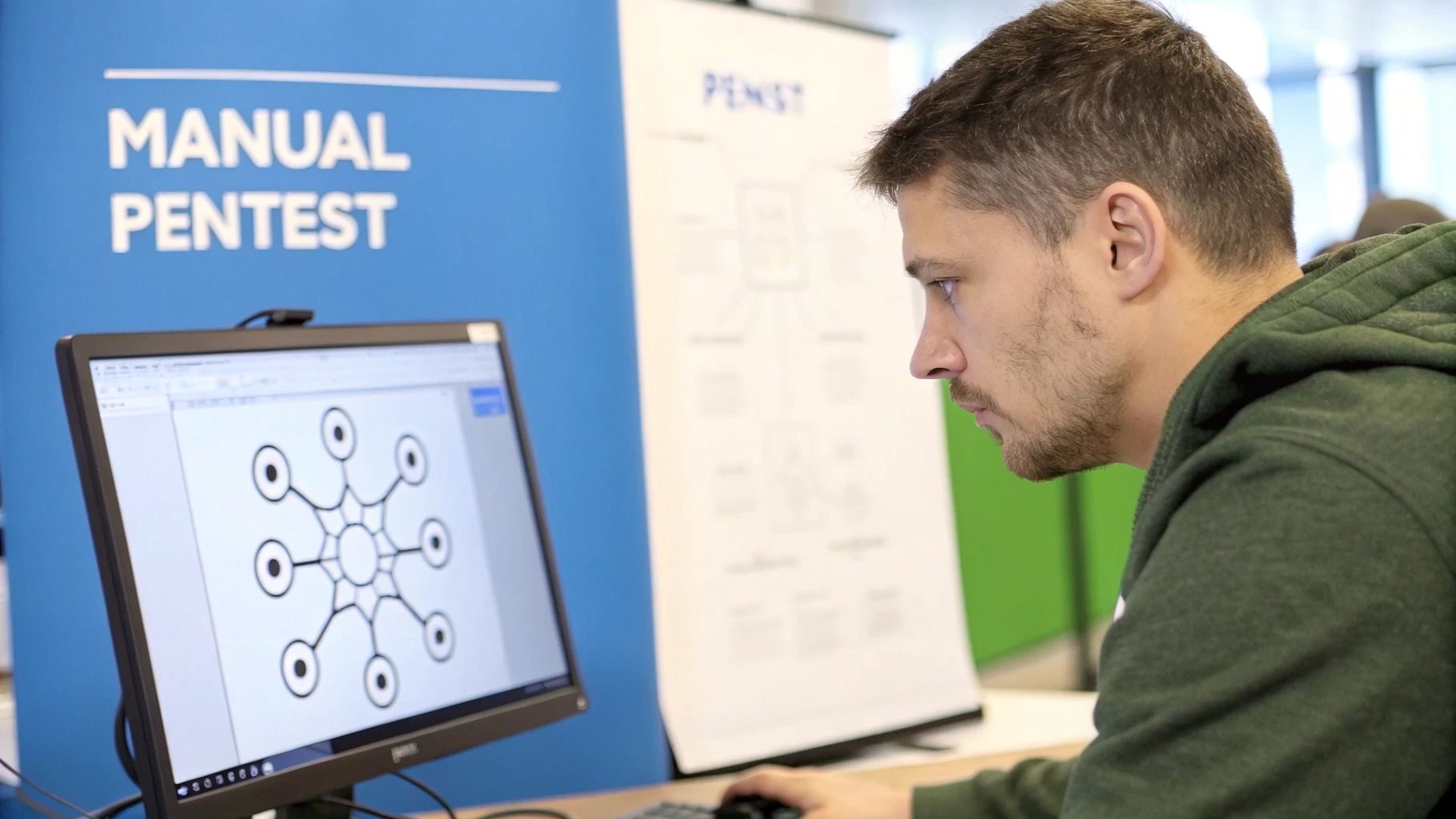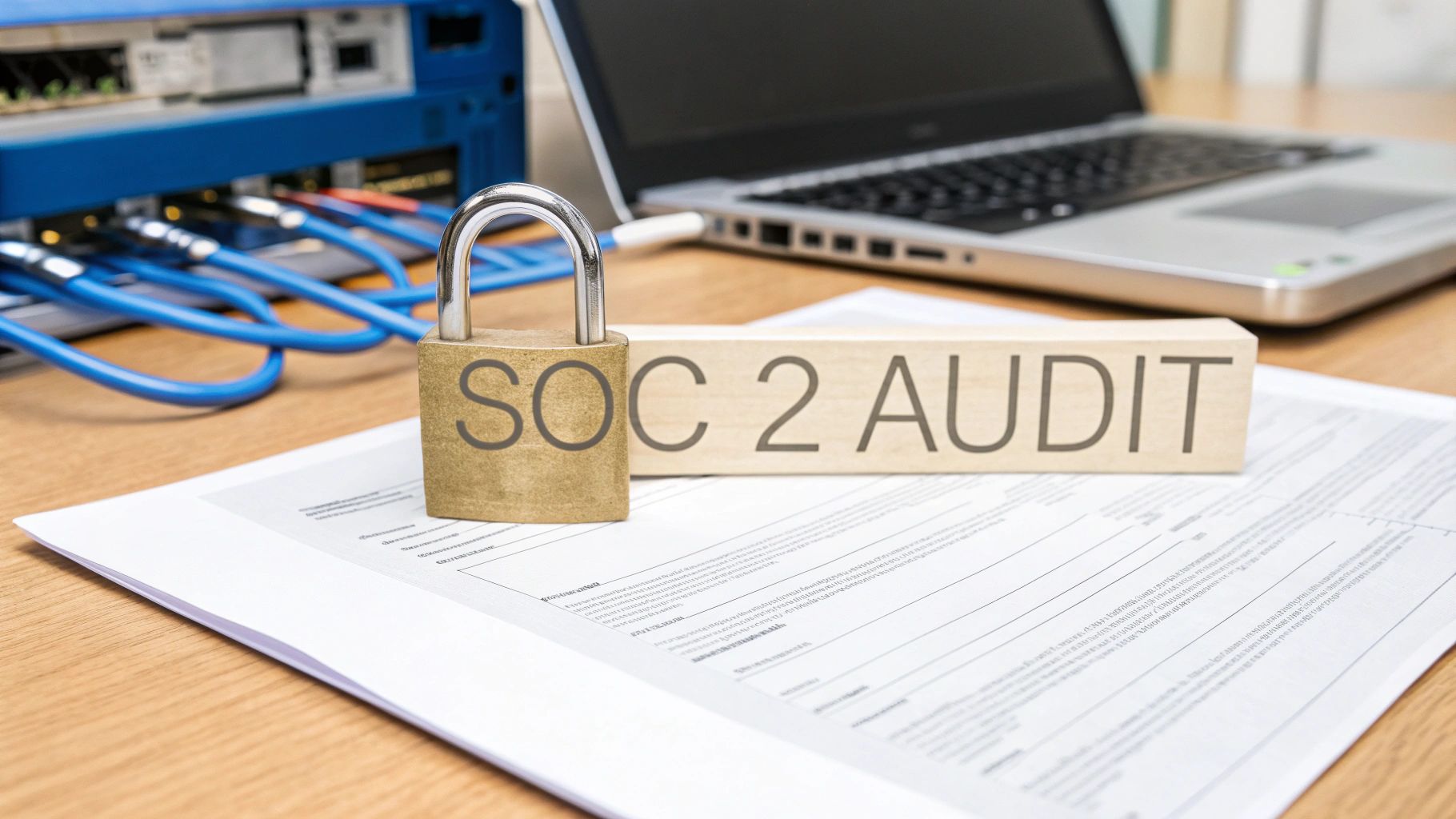If you're an MSP, vCISO, or GRC firm, you know that understanding SOC 2 audit requirements is a must for your clients. It's a key part of building trust and proving they can handle customer data securely. The goal is simple: get a thumbs-up from an independent CPA firm that security controls are designed and operating effectively.
Think of a SOC 2 audit as a flexible framework, not a rigid checklist. This is a huge plus compared to frameworks like PCI DSS or HIPAA, which have very specific rules. SOC 2 gives companies room to show their security in a way that actually fits how they operate.
SOC 2 Pentesting Requirements
The SOC 2 framework is built around five core principles called the Trust Services Criteria (TSCs). This is where you, as a trusted advisor, can help clients scope their audit by picking the right criteria. A major part of this process involves security testing to validate controls.
When it comes to penetration testing, SOC 2 has a gray area. It doesn't explicitly say "you must perform a manual pentest." This leads many to believe they can get by with a simple automated vulnerability scan. In fact, SOC 2 is one of the only frameworks where you might be able to get away with automated testing, but it's a risky shortcut.

Automated scanners are great for finding known vulnerabilities, but they're blind to business logic flaws that lead to major breaches. Our manual pentesting, performed by OSCP, CEH, and CREST certified pentesters, replicates the creative thinking of a real attacker. This gives your clients the concrete evidence they need for a smooth audit and positions you as an expert for SOC 2, ISO 27001, and more.
Understanding The Five Trust Services Criteria
The Trust Services Criteria are the heart of any SOC 2 audit. Helping your clients choose the right ones is a huge value-add for any MSP, vCISO, or GRC consultant. While Security is mandatory, the other four are chosen based on the services a company provides.
This is where you come in. Your role as a reseller is to turn these principles into a concrete action plan. This is the perfect time to introduce key services like risk assessments and penetration testing. By partnering with us, you can offer expert help without the inflated prices and long lead times found elsewhere. Our channel-only model means we provide fast, affordable, manual pentesting you can resell under your brand.
The Security Criterion a Mandatory Foundation
The Security criterion is the mandatory foundation of every SOC 2 audit. It's often called the "Common Criteria" because its principles overlap with the other four TSCs. The goal is to prove you can protect systems and data against unauthorized access.
This means having controls for network firewalls, intrusion detection, two-factor authentication, and physical access. A key part of the Security criteria is having an effective Incident Response Plan. This is your bread and butter as an MSP or vCISO, allowing you to offer crucial services like risk assessments and vulnerability management.
Availability and Keeping The Lights On
The Availability criterion is all about uptime and is crucial for any company that promises a certain level of performance in a Service Level Agreement (SLA). If your client guarantees 99.9% uptime, this criterion proves they have the technical muscle to back it up.
This involves things like performance monitoring, disaster recovery plans, and network redundancy. If a service outage would be a major problem for your client's customers, you should strongly recommend including Availability in their SOC 2 scope.
Confidentiality for Protecting Sensitive Data
Think of the Confidentiality criterion as a digital vault for sensitive, non-public information. This isn't just customer data; it can be business plans, intellectual property, or internal financial records. The goal is simple: ensure this data is only seen by authorized people.
Key controls often involve data encryption, strict access controls, and secure data disposal methods. For any business handling proprietary information, this criterion is essential for building trust.
Processing Integrity and Ensuring Accurate Operations
Processing Integrity focuses on how a system works. It’s all about proving that when your client's system processes data—like an invoice or a transaction—it does so completely, accurately, and on time.
This is a big deal for financial platforms or any business where a calculation error could have serious consequences. An auditor will check that the system operates exactly as it's supposed to, without errors or manipulation.
Privacy for Safeguarding Personal Information
Finally, the Privacy criterion focuses on how you collect, use, store, and dispose of Personally Identifiable Information (PII). It’s easy to confuse this with Confidentiality, but Privacy is all about protecting individuals' data, like names, addresses, and other personal details. The controls here often overlap with regulations you already know, like GDPR.
Why Manual Pentesting is Better For SOC 2
While SOC 2 is one of the few frameworks that might let you slide with automated scanning, it’s a risky shortcut. Relying only on automated tools creates a false sense of security. It feels like a quick, cheap way to check a box, but it often leads to failed audit points or a preventable security incident.
An auditor's job is to confirm that security controls are effective, not just in place. A scanner report only tells half the story. A manual pentest from a certified pro is the best way to satisfy key controls like CC4.1 (risk assessment) and CC7.1 (vulnerability management), providing the proof an auditor needs.

Our team of OSCP, CEH, and CREST certified pentesters thinks like real-world attackers. They chain together low-risk vulnerabilities to create high-impact exploits something an automated scanner could never do. By offering our fast, affordable, and white label pentesting services, you give your clients what they need: a thorough security assessment that validates controls and satisfies auditors. Check out our guide on how to perform penetration testing for more insight.
SOC 2 Type I vs Type II Reports
When guiding a client through their first SOC 2 audit, you'll need to explain the difference between a Type I and Type II report. A SOC 2 Type I report is like a photo—a snapshot in time. An auditor reviews controls on a single day to confirm they are designed correctly.
A SOC 2 Type II report is like a video. It proves the controls actually worked over a period of time, usually six to twelve months. This is what most enterprise customers want to see. Today, a Type II report is a non-negotiable for closing deals with larger companies. For more details, check out these insights on the SOC 2 audit process.

The annual nature of Type II audits turns compliance into a year-round engagement, creating a recurring revenue stream for you. This is where our white label pentesting fits perfectly. Every year, as your client prepares for their audit, our fast, manual pentesting provides the evidence they need to pass. You resell our services, maintain the client relationship, and help them sail through their audit.
Your Practical SOC 2 Audit Checklist
Getting a client ready for a SOC 2 audit is manageable with a clear plan. Preparation is everything. By breaking it down, you can guide any client from start to finish successfully.
First, define the audit scope by deciding which of the five Trust Services Criteria apply. Next, perform a gap analysis and a thorough risk assessment to identify threats and prioritize vulnerabilities. This is a perfect place for an MSP or vCISO to offer our affordable, white-label services. From there, you'll help your client remediate gaps by implementing new security controls, like conducting a manual penetration test to prove security works. A huge piece of this puzzle is also managing third-party risk, which you can read more about in our guide on the third-party risk management process.
Finally, you’ll gather documentation and evidence to show controls are working. An auditor won't take your word for it they need proof. Organized documentation is your best friend. By following this checklist, you become a strategic GRC partner, making the SOC 2 audit manageable and successful for your client.
Let a Pentest Partner Handle The Testing
Getting your clients through a SOC 2 audit can be a maze of high costs and confusing requirements. You can offer something better, faster, and more affordable than overpriced firms that might try to steal your client. We are a channel-only partner, meaning we never compete with our MSP or vCISO clients.
Our value proposition is simple: fast, affordable, and fully manual penetration testing delivered as a seamless white label pentesting service. Our OSCP, CEH, and CREST certified pentesters find the critical issues automated scans miss, giving your clients the assurance they need. Stop letting slow turnarounds and inflated quotes limit your service quality.
Ready to give your clients the best pentesting experience they've ever had? See what it's like to work with a real pentest partner and let's start growing your business together.
Common Questions About SOC 2 Audits
If you’re guiding clients through their first SOC 2, you’ll likely hear the same questions repeatedly. Knowing the answers helps keep the process on track. Here are some of the most common questions we hear from our MSP and vCISO partners.
A SOC 2 Type I audit can be quick, sometimes just a few weeks after controls are in place. But a Type II report covers a 6-12 month observation window, so the entire process can take eight months to over a year. The cost varies widely, from $10,000 to over $60,000, depending on the audit scope, company size, and control maturity. Using affordable, high-quality vendors for services like penetration testing helps keep costs down.
You don't "pass" or "fail" a SOC 2 audit. The goal is to get an "unqualified" opinion, which means everything looks good. An "adverse" opinion means there are significant problems, which can be a deal-killer. Proactive readiness, including a thorough manual pentest, helps you find and fix issues before an auditor sees them, ensuring a clean report.
At MSP Pentesting, we give our partners the tools to deliver top-tier, affordable security solutions that make compliance way less painful. Our channel-only, white-label pentesting services mean you can guide your clients through their audits with total confidence. Learn more by visiting us at https://msppentesting.com.



.avif)
.png)